Bullying is the practice of influencing another party to do something it does not want to do by using threats or actual force. Synonyms include coercion and intimidation. All states have a legal duty to ‘refrain in their international relations from military, political, economic or any other form of coercion aimed against the political independence or territorial integrity of any State’. Coercion rising to a threat to use force against the territorial or peace and security of any state would be a direct violation of the UN Charter.
On 21 July 2019, the US State Department released a statement accusing China of bullying some Southeast Asian countries and threatening regional energy security by blocking their access to ‘unexploited hydrocarbon resources’. China has also been undertaking marine scientific research in Vietnam’s legitimate Exclusive Economic Zone (EEZ) in spite of Vietnam’s protests.
According to US State Department spokesperson Morgan Ortagus, the actions of the survey vessel are ‘an escalation by Beijing in its efforts to intimidate other claimants out of developing resources in the South China Sea’. Having coast guard and purported ‘maritime militia’ vessels accompany the government research ship gives the impression that China is using threats of use of force to back up its illegal incursion. Australia’s Prime Minister Scott Morrison joined the chorus, urging China’s neighbours to resist ‘coercion’.
China has a history of intimidating both states and their contracted international oil companies to cease operations in areas that fall within its discredited nine-dash line. Both Vietnam and the Philippines have accused China of interfering with petroleum exploration in their EEZs.
These incidents are also being considered in the context of China’s other recent aggressive behaviour — like its seizure of Scarborough Shoal and its massing of fishing boats near contested features occupied by the Philippines.
If there were any doubt that China has threatened to use force in its maritime disputes, in May 2017 President Rodrigo Duterte of the Philippines claimed that China had threatened war if the Philippines tried to implement its arbitration victory against China by drilling for oil in areas claimed by China.
It would appear that China has engaged in bullying. What about the United States?
On 29 August, after the most recent US freedom of navigation operation (FONOP), China accused the United States of bullying and ‘asserting maritime hegemony’. US FONOPs challenge China’s territorial and jurisdictional claims with warships and war planes — they are often referred to by critics as ‘gunboat diplomacy’. Given that US FONOPs have been directed against the claims of almost all South China Sea coastal countries, this perception is not confined to China.
In March 2018, the USS Carl Vinson strike force was deployed to the South China Sea. Its mission included demonstration of ‘freedom of navigation’ presumably in the face of perceived threats. In other words, one intention was to convince China not to interfere with the free navigation of warships and to rescind Chinese claims that the United States considers inconsistent with the UN Convention on the Law of the Sea (UNCLOS).
Was this deployment of one of the most powerful symbols of US military power with the intent of making China change its policy an example of a threat that violates the UN Charter? It is hard to know definitively — the United States has not ratified UNCLOS and cannot be brought before or avail itself of its dispute settlement mechanisms. That may be one reason why it uses gunboat diplomacy instead.
No country should acquiesce to jurisdictional claims that it considers disadvantageous or illegal. But non-acquiescence can effectively be demonstrated by written statements and diplomatic communication instead of gunboats. The diplomatic option seems to be sufficient for other nations, including maritime powers whose rights the United States claims to be protecting.
So both China and the United States are bullying smaller Southeast Asian countries. The United States is also bullying China — at least in China’s eyes. This spate of bullying is part and parcel of the US–China struggle for military, economic and political dominance in the region. But as Singapore’s Defence Minister Ng Eng Hen observes, ‘the challenge for the United States and China is to offer acceptance of their dominance beyond military might. If their policies are lopsided against other countries’ interests, these countries will seek other partners’. Malaysia, Indonesia and the Philippines have also expressed concern with US projection of power and other unwelcome actions in the region.
Yet bullying is part of the history of international relations.
As Thucydides supposedly put it, ‘the strong do what they can; the weak suffer what they must’. Bullying begets bullying and it will continue despite international law and pontifications and promises to the contrary. Meanwhile, for China and the United States it seems wise to heed the advice that ‘those who live in glass houses should not throw stones’.
Mark J Valencia is Adjunct Senior Scholar at the National Institute for South China Sea Studies (NISCSS), Haikou, China.

